Pera
This article is incomplete because it is pending further input from participants, or it is a work-in-progress by one author. Please comment on this article's talk page to share your input, comments and questions. Note: To contribute to this article, you may need to seek help from the author(s) of this page. |
Republic of Pera República de Pera (Columbian) | |
|---|---|
|
Flag | |
 | |
| Capital | Winima |
| Largest city | San Ralana |
| Official languages |
|
| Religion |
|
| Demonym(s) | Peran |
| Government | Unitary Premist Republic |
• Premier | Iridián San Agustín |
• Surrogate Premier | Odalis Pavon |
• Minister of the House | Nayeli Miles |
| Legislature | National Assembly |
| Area | |
• Total | 222,137 km2 (85,768 sq mi) (57th) |
| Population | |
• 3000 census | 92,171,592 (35th) |
• Density | 414.9/km2 (1,074.6/sq mi) (18th) |
| GDP (PPP) | 3000 estimate |
• Total | $5.198 trillion (28th) |
• Per capita | $56,392 (22nd) |
| GDP (nominal) | 3000 estimate |
• Total | $4.792 trillion (25th) |
• Per capita | $51,986 (21st) |
| Gini (3000) | 39.5 medium (38th (tie)) |
| HDI (3000) | 0.864 very high (23rd) |
| Currency | Peran Inti (PEI) |
| Time zone | UTC+6.5 (Central American Time) |
Pera, officially the Republic of Pera, is a nation in central America. It is bordered by Tas to the north, Sury to the southwest, Kecha to the southeast, and Hud to the east. It has a coast with Lake Superior to the east.
Pera ranks moderately high for civil liberties and political freedom. All civil liberties are respected and written in law, however there have always been restrictions on various liberties including speech and privacy. Regulations on protest, especially political, have opened the possibility of tyranny over the years, however it has never progressed to dictatorial or totalitarian tendencies.
Pera’s economy is strongly based in tourism and farming. Pera is a popular vacation spot along with Kecha for American nations. Its tropical climate allows for a tropically diverse food economy. Pera has developed and reincarnated various tropical fruits, including artificially created fruit and especially citrus. Pera is also home to the largest variety of fruit; the Rojano. This fruit is a core symbol of Peran culture and also was responsible for the boom in Peran tourism. Since Pera’s economy is vulnerable to a variety of variables, Pera has had talks about starting a new economic union with Kecha, Sury, and Loklan.
Etymology
Pera is derived from the name of the country of Peru which existed from 1821 to 2278. Peru itself has an unknown origin and was so named in the 1500s by Spanish explorers.
